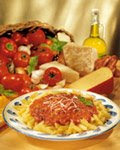
Nasi lemak is a dish that is commonly sold in Malaysia, Brunei, Southern Thailand and Singapore. In fact, it has been called the unofficial national dish of Malaysia. In the east coast Terengganu and Kelantan, Nasi Dagang is very common. There is a similar dish in Indonesia called nasi uduk.
With roots in Malay culture, its name is a Malay word that literally means 'rice in fat'. The name is derived from the cooking process whereby rice is soaked in rich coconut cream and then the mixture steamed. Sometimes knotted screwpine (pandan) leaves are thrown into the rice while steaming to give it more fragrance. Occasionally, other herbs such as ginger and lemon grass may also be added for additional fragrance.
Traditionally, this comes as a platter with cucumber slices, small dried anchovies (ikan bilis), roasted peanuts, stir fried water convolvulus (kangkong), hard boiled egg, pickled vegetables (achar) and hot spicy sauce (sambal). Nasi lemak can also come with any other accompaniments such as chicken, cuttlefish, cockle, beef curry (beef stewed in coconut milk and spices) or paru (beef lungs). Traditionally most of these accompaniments are spicy in nature.
Nasi lemak is traditionally a breakfast dish, and it is sold early in the morning at roadside stalls in Malaysia, where it is often sold packed in newspaper, brown paper or banana leaf. However, there are restaurants which serve it on a plate as noon or evening meals, making it possible for the dish to be treated as a delicacy. 'Nasi lemak panas' meaning hot nasi lemak is another name given to nasi lemak serve with hot cooked rice.
Simply rice cooked in coconut milk (knotted pandanus leaves and even ginger or a stalk of lemon grass may be tossed into the pot to add fragrance), imparting a creamy texture to the grains, nasi lemak is available on almost every street corner and in almost every local-themed restaurant, served with everything from chicken to beef to cuttlefish.
It can be eaten at any time - breakfast, second breakfast, elevenses, lunch, tea, dinner, supper, post-boozeup - and the mingling of flavours and textures (creamy, hot & spicy, crunchy, nutty, etc) makes it simply … sheer ambrosia.
Essential condiments:
Fried ikan bilis (anchovies)
Fried peanuts
Cucumber slices
Wedges of hardboiled egg (variations: fried eggs, or slices of omelette)
Sambal (a kind of cooked chili paste, plain with onions or with ikan bilis too)
Extras:
Chicken curry or rendang
Beef curry or rendang
Mutton curry or rendang
Cuttlefish sambal or curry
Chicken liver and gizzard curry
Fried chicken
Fried cow lung (paru)
Begedil (potato cutlets sometimes mixed with minced meat)
Dried prawns sambal (some non-halal outlets cook this with minced pork)
Cockles in sambal
Stewed kangkong (water spinach)















No comments:
Post a Comment